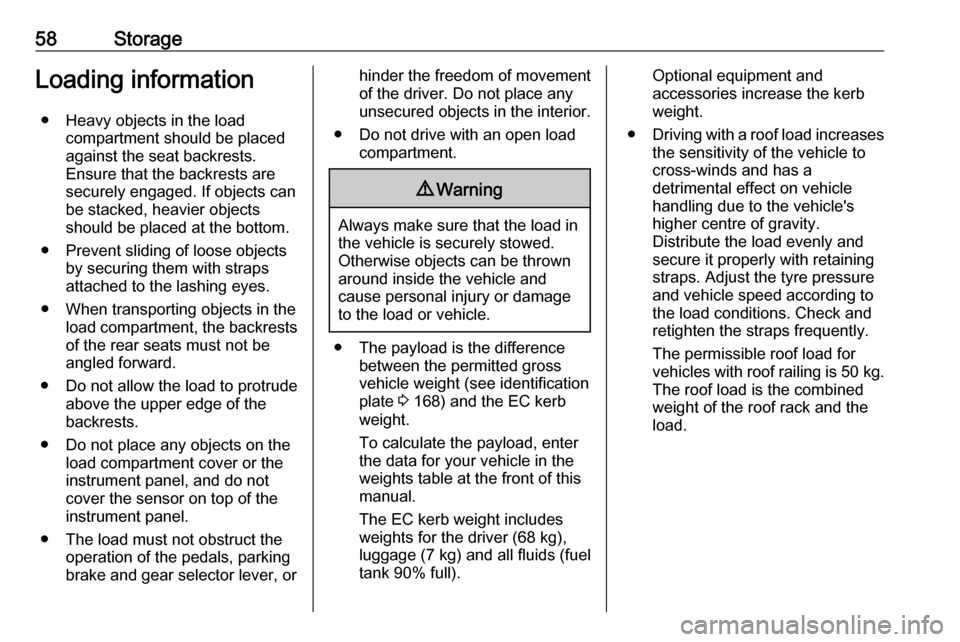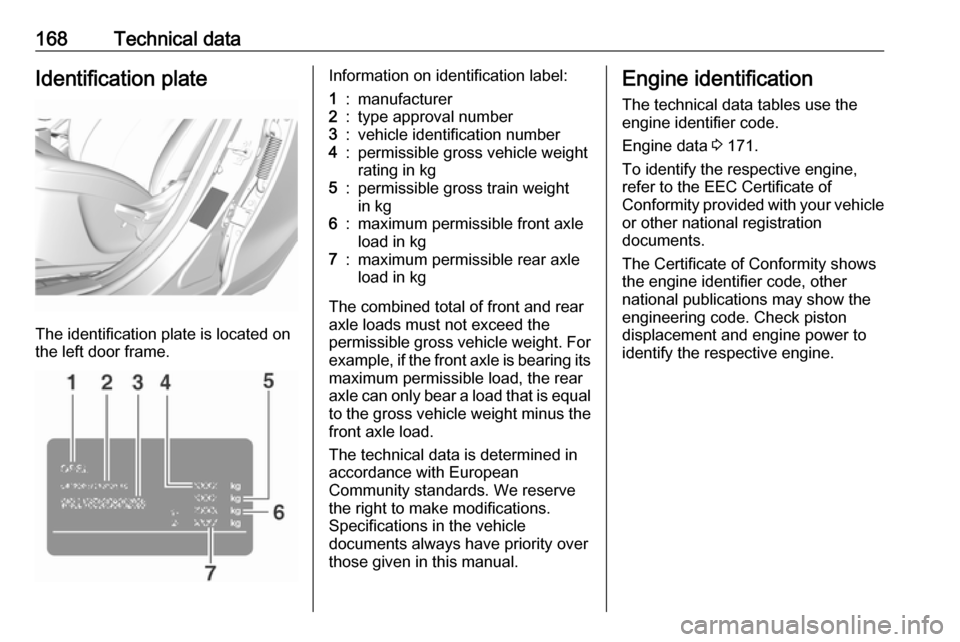weight OPEL KARL 2019 Owner's Manual
[x] Cancel search | Manufacturer: OPEL, Model Year: 2019, Model line: KARL, Model: OPEL KARL 2019Pages: 191, PDF Size: 5.51 MB
Page 50 of 191

48Seats, restraintsSelecting the right systemThe rear seats are the most
convenient location to fasten a child
restraint system.
Children should travel facing
rearwards in the vehicle as long as
possible. This ensures that the child's backbone, which is still very weak, is
under less strain in the event of an
accident.
Suitable are restraint systems that
comply with valid UN ECE
regulations. Check local laws and
regulations for mandatory use of child restraint systems.
Ensure that the child restraint system to be installed is compatible with the
vehicle type.
Refer to the tables on the following
pages, the instructions supplied with
the child restraint system and the
vehicle type list of non-universal child
restraint systems.The following child restraints are
recommended for the following
weight classes:
● Group 0, Group 0+
Maxi Cosi Cabriofix with ISOFIX
base, for children up to 13 kg
● Group I
Duo Plus with ISOFIX and Top
tether, for children from 9 kg to
18 kg in this group
● Group II, Group III
Kidfix XP with or without ISOFIX
for children from 15 kg to 36 kg
Nania / OSANN Dream Booster
with or without ISOFIX for
children from 22 kg to 36 kg
Ensure that the mounting location of
the child restraint system within the
vehicle is correct, see following
tables.
Allow children to enter and exit the
vehicle only on the side facing away
from the traffic.
When the child restraint system is not in use, secure the seat with a seat belt
or remove it from the vehicle.Note
Do not affix anything on the child
restraint systems and do not cover
them with any other materials.
A child restraint system which has
been subjected to stress in an
accident must be replaced.
Page 51 of 191

Seats, restraints49Child restraint installation locations
Permissible options for fastening a child restraint system with a three-point seat belt
Weight class
On front passenger seat
On rear outboard seatsOn rear centre seat
activated airbagdeactivated airbagGroup 0: up to 10 kgXU 1U 2XGroup 0+: up to 13 kgXU1U2XGroup I: 9 to 18 kgXU1U 2, 3XGroup II: 15 to 25 kgXXU2, 3XGroup III: 22 to 36 kgXXU2, 3XU:universal suitability in conjunction with three-point seat beltX:no child restraint system permitted in this weight class1:adjust seat backrest as far as necessary to a vertical position to ensure that the belt runs forwards from the upper
anchorage point2:move the driver and/or passenger seat forwards and adjust seat backrest as far as necessary to a vertical positionto ensure that the child restraint system does not have any interference from the front seat backrest.3:adjust the respective headrest as necessary or remove if required.
Page 52 of 191

50Seats, restraintsPermissible options for fitting an ISOFIX child restraint systemWeight classSize classFixtureOn front passenger seatOn rear outboard seatsOn rear centre seatGroup 0: up to 10 kgFISO/L1XXXGISO/L2XXXEISO/R1XIL1XGroup 0+: up to 13 kgEISO/R1XIL 1XDISO/R2XIL1XCISO/R3XIL1XGroup I: 9 to 18 kgDISO/R2XIL1,2XCISO/R3XIL1,2XBISO/F2XIL, IUF 1,2XB1ISO/F2XXIL, IUF1,2XAISO/F3XIL, IUF 1,2XGroup II: 15 to 25 kgXIL1,2XGroup III: 22 to 36 kgXIL1,2XIL:suitable for particular
ISOFIX restraint systems of the "specific-vehicle", "restricted" or "semi-universal" categories.
The ISOFIX restraint system must be approved for the specific vehicle type (refer to the vehicle type list of the child
restraint system)IUF:suitable for ISOFIX forward-facing child restraint systems of universal category approved for use in this weight class
Page 53 of 191

Seats, restraints51X:no ISOFIX child restraint system approved for this weight class1:only applicable for rear outer seat on passenger side with foremost seating position and backrest upright.2:adjust the respective headrest as necessary or remove if required.
Note
Move the driver and/or passenger seat forwards and adjust seat backrest inclination as far as necessary to a vertical position to ensure that the child restraint system does not have any interference from the front seat backrest.
ISOFIX size class and seat device
A – ISO/F3:forward-facing child restraint system for children of maximum size in the weight class 9 to 18 kgB – ISO/F2:forward-facing child restraint system for smaller children in the weight class 9 to 18 kgB1 – ISO/F2X:forward-facing child restraint system for smaller children in the weight class 9 to 18 kgC – ISO/R3:rear-facing child restraint system for children of maximum size in the weight class up to 18 kgD – ISO/R2:rear-facing child restraint system for smaller children in the weight class up to 18 kgE – ISO/R1:rear-facing child restraint system for young children in the weight class up to 13 kgF - ISO/L1:left lateral facing position CRS (carry cot) for smaller children in the weight class up to 10 kgG - ISO/L2:right lateral facing position CRS (carry cot) for smaller children in the weight class up to 10 kg.
Permissible options for fitting an i-size child restraint system with ISOFIX brackets
On front passenger seat
On rear outboard seatsOn rear centre seat
activated airbagdeactivated airbagi-size child restraint systemsXXXXi - U:suitable for i-size 'universal' forward and rearward facing child restraint systemsX:seating position not suitable for i-size 'universal' child restraint systems
Page 60 of 191

58StorageLoading information● Heavy objects in the load compartment should be placedagainst the seat backrests.
Ensure that the backrests are
securely engaged. If objects can
be stacked, heavier objects
should be placed at the bottom.
● Prevent sliding of loose objects by securing them with straps
attached to the lashing eyes.
● When transporting objects in the load compartment, the backrests
of the rear seats must not be
angled forward.
● Do not allow the load to protrude above the upper edge of the
backrests.
● Do not place any objects on the load compartment cover or theinstrument panel, and do not
cover the sensor on top of the instrument panel.
● The load must not obstruct the operation of the pedals, parking
brake and gear selector lever, orhinder the freedom of movement of the driver. Do not place any
unsecured objects in the interior.
● Do not drive with an open load compartment.9Warning
Always make sure that the load in
the vehicle is securely stowed.
Otherwise objects can be thrown
around inside the vehicle and
cause personal injury or damage
to the load or vehicle.
● The payload is the difference between the permitted gross
vehicle weight (see identification
plate 3 168) and the EC kerb
weight.
To calculate the payload, enter
the data for your vehicle in the
weights table at the front of this
manual.
The EC kerb weight includes
weights for the driver (68 kg),
luggage (7 kg) and all fluids (fuel
tank 90% full).
Optional equipment and
accessories increase the kerb
weight.
● Driving with a roof load increases
the sensitivity of the vehicle to
cross-winds and has a
detrimental effect on vehicle
handling due to the vehicle's
higher centre of gravity.
Distribute the load evenly and secure it properly with retaining
straps. Adjust the tyre pressure
and vehicle speed according to
the load conditions. Check and
retighten the straps frequently.
The permissible roof load for
vehicles with roof railing is 50 kg.
The roof load is the combined
weight of the roof rack and the
load.
Page 147 of 191

Vehicle care145Vehicles with spare wheel
The jack and the vehicle tools are in
the load compartment.
Wheels and tyres
Tyre condition, wheel condition Drive over edges slowly and at right
angles if possible. Driving over sharp
edges can cause tyre and wheel
damage. Do not trap tyres on the kerb when parking.
Regularly check the wheels for
damage. Seek the assistance of a
workshop in the event of damage or
unusual wear.
We recommend not swapping the
front wheels with the rear wheels and vice versa, as this can affect vehicle
stability. Always use less worn tyres on the rear axle.
Winter tyres
Winter tyres improve driving safety at temperatures below 7 °C and should
therefore be fitted on all wheels.
In accordance with country-specific
regulations, affix the speed sticker in
the driver's field of view.Tyre designations
E.g. 195/55 R 16 95 H195:tyre width, mm55:cross-section ratio (tyre height
to tyre width), %R:belt type: RadialRF:type: RunFlat16:wheel diameter, inches91:load index e.g. 91 is equivalent
to 615 kgH:speed code letter
Speed code letter:
Q:up to 160 km/hS:up to 180 km/hT:up to 190 km/hH:up to 210 km/hV:up to 240 km/hW:up to 270 km/h
Choose a tyre appropriate for the
maximum speed of your vehicle.
The maximum speed is achievable at kerb weight with driver (75 kg) plus
125 kg payload. Optional equipment
could reduce the maximum speed of
the vehicle.
Performance 3 172.
Page 170 of 191

168Technical dataIdentification plate
The identification plate is located on
the left door frame.
Information on identification label:1:manufacturer2:type approval number3:vehicle identification number4:permissible gross vehicle weight rating in kg5:permissible gross train weight
in kg6:maximum permissible front axle
load in kg7:maximum permissible rear axle
load in kg
The combined total of front and rear
axle loads must not exceed the
permissible gross vehicle weight. For
example, if the front axle is bearing its
maximum permissible load, the rear
axle can only bear a load that is equal
to the gross vehicle weight minus the front axle load.
The technical data is determined in
accordance with European
Community standards. We reserve
the right to make modifications.
Specifications in the vehicle
documents always have priority over
those given in this manual.
Engine identification
The technical data tables use the
engine identifier code.
Engine data 3 171.
To identify the respective engine,
refer to the EEC Certificate of
Conformity provided with your vehicle
or other national registration
documents.
The Certificate of Conformity shows the engine identifier code, other
national publications may show the
engineering code. Check piston
displacement and engine power to
identify the respective engine.
Page 174 of 191
![OPEL KARL 2019 Owners Manual 172Technical dataVehicle dataMaximum speed [km/h]170Minimum / maximum kerb weight
[kg] 3)938 / 1034Engine oil
including filter [l]3.5Engine oil
between MIN and MAX [l]1.0Fuel tank
Petrol, refilling q OPEL KARL 2019 Owners Manual 172Technical dataVehicle dataMaximum speed [km/h]170Minimum / maximum kerb weight
[kg] 3)938 / 1034Engine oil
including filter [l]3.5Engine oil
between MIN and MAX [l]1.0Fuel tank
Petrol, refilling q](/img/37/18884/w960_18884-173.png)
172Technical dataVehicle dataMaximum speed [km/h]170Minimum / maximum kerb weight
[kg] 3)938 / 1034Engine oil
including filter [l]3.5Engine oil
between MIN and MAX [l]1.0Fuel tank
Petrol, refilling quantity [l]323) Optional accessories increase the kerb weight.
Loading information 3 58.